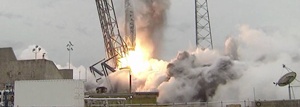SpaceX supply mission to ISS explodes minutes after launch
29 Jun 2015
A supply mission by an unmanned SpaceX Falcon-9 rocket exploded within minutes after blast off at 10:21 am local time on Sunday over the skies of Cape Canaveral, Florida.

The rocket, carrying its Dragon cargo spacecraft,was carrying supplies and equipment destined for the International Space Station.
The explosion occurred before the first stage was set to separate, a SpaceX spokesman said during the company's webcast.
"The vehicle has broken up," said NASA commentator George Diller, after the live webcast of the launch went silent about two minutes 19 seconds into the flight, and soon after the rocket could be seen exploding and small pieces tumbling back toward Earth.
"We appear to have had a launch vehicle failure," Diller said.
"At this point it is not clear to the launch team exactly what happened."
Moments later, a SpaceX commentator said the video link from the vehicle had been lost.
"There was some kind of anomaly during first stage flight," the commentator said, noting that the rocket had ignited its nine Merlin engines and reached supersonic speed.
"However, it appears something did occur during first stage operations," he added, referring to the stage of rocket flight before the cargo ship would have been able to separate from the first stage of the rocket and reach orbit.
SpaceX CRS-7 was the seventh mission to the International Space Station that SpaceX was to fly for NASA under the CRS contract.
In December 2008, NASA announced that SpaceX's Falcon 9 launch vehicle and Dragon spacecraft had been selected to resupply the space station after the end of the Space Shuttle programme in 2011.
Under the CRS contract, SpaceX has restored an American capability to deliver and return significant amounts of cargo, including live plants and animals, to and from the orbiting laboratory.
The Dragon cargo ship was fitted with 4,000 pounds (1,800 kg) of supplies and payloads, including a large parking space, known as an International Docking Adaptor, designed to make it easier for an array of commercial crew spacecraft to dock at the orbiting lab in the future.
The payloads included critical materials to support more than 30 student research investigations and more than 35 of approximately 250 science and research investigations that will occur during Expeditions 44 and 45.
Science payloads will offer new insight to combustion in microgravity, perform the first space-based observations of meteors entering Earth's atmosphere, continue solving potential crew health risks, and make new strides toward being able to grow food in space.
After liftoff, SpaceX had planned to make a third try at a controlled, upright landing of its Falcon 9 rocket on an ocean platform with the goal of one day making rockets as reusable as airplanes.
NASA Administrator Charles Bolden said, ''We are disappointed in the loss of the latest SpaceX cargo resupply mission to the International Space Station. However, the astronauts are safe aboard the station and have sufficient supplies for the next several months. We will work closely with SpaceX to understand what happened, fix the problem and return to flight. The commercial cargo programme was designed to accommodate loss of cargo vehicles. We will continue operation of the station in a safe and effective way as we continue to use it as our test bed for preparing for longer duration missions farther into the solar system.
''A Progress vehicle is ready to launch July 3, followed in August by a Japanese HTV flight. Orbital ATK, our other commercial cargo partner, is moving ahead with plans for its next launch later this year.
''SpaceX has demonstrated extraordinary capabilities in its first six cargo resupply missions to the station, and we know they can replicate that success. We will work with and support SpaceX to assess what happened, understand the specifics of the failure and correct it to move forward. This is a reminder that spaceflight is an incredible challenge, but we learn from each success and each setback. Today's launch attempt will not deter us from our ambitious human spaceflight programme.''





















